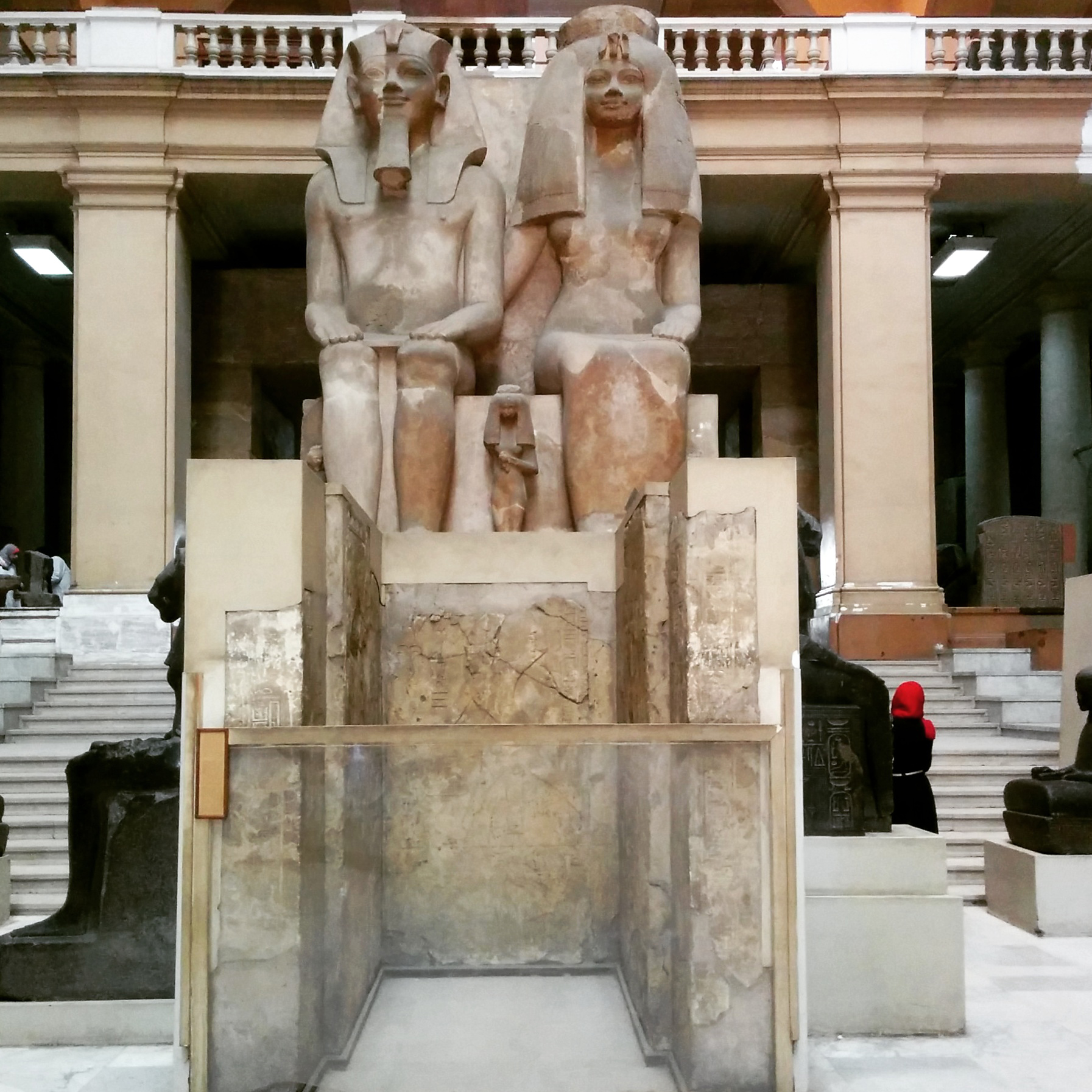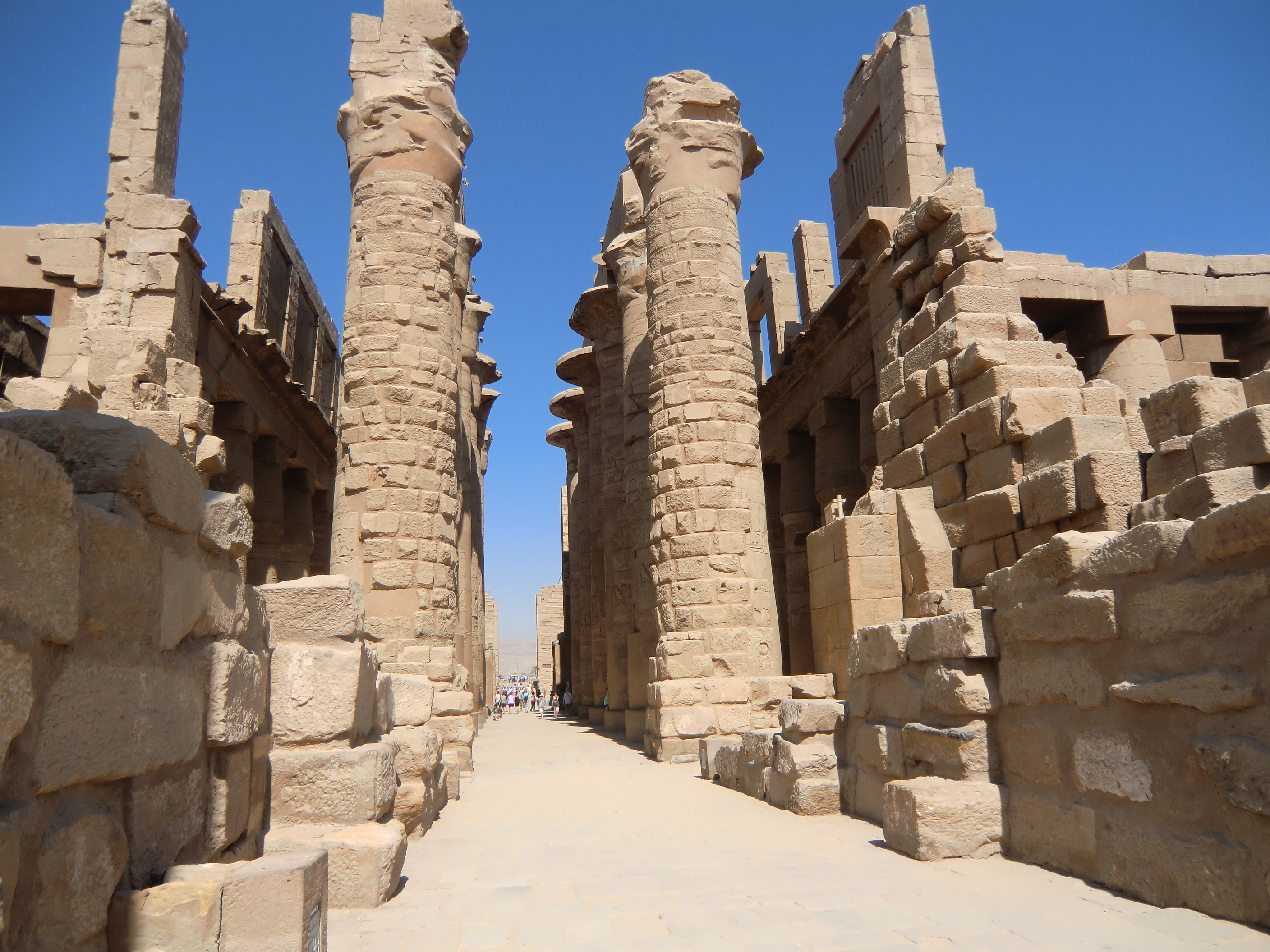|
Colossal Statue Of Amenhotep III And Tiye
The colossal statue of Amenhotep III and Tiye is a monolith group statue of Egyptian pharaoh Amenhotep III of the eighteenth dynasty, his Great Royal Wife Tiye, and three of their daughters. It is the largest known dyad ever carved.W. Raymond Johnson: Monuments and Monumental Art under Amenhotep III. In: Amenhotep III: Perspectives on His Reign. (edited by David O'Connor, Eric H. Cline) p.73 The statue originally stood in Medinet Habu, Western Thebes; today it is the centerpiece of the main hall of the Egyptian Museum in Cairo. Description The statue is made of limestone, its width is 4,4 m, its height is 7 m. The almond shaped eyes and curved eyebrows of the figures are of typical late 18th dynasty style. Amenhotep III wears the ''nemes'' headdress with uraeus, a false beard and a kilt; he is resting his hands on his knees. Queen Tiye is sitting on his left, her right arm is placed around her husband's waist. Her height is equal to that of the pharaoh, which shows her prominen ... [...More Info...] [...Related Items...] OR: [Wikipedia] [Google] [Baidu] |
Limestone
Limestone ( calcium carbonate ) is a type of carbonate sedimentary rock which is the main source of the material lime. It is composed mostly of the minerals calcite and aragonite, which are different crystal forms of . Limestone forms when these minerals precipitate out of water containing dissolved calcium. This can take place through both biological and nonbiological processes, though biological processes, such as the accumulation of corals and shells in the sea, have likely been more important for the last 540 million years. Limestone often contains fossils which provide scientists with information on ancient environments and on the evolution of life. About 20% to 25% of sedimentary rock is carbonate rock, and most of this is limestone. The remaining carbonate rock is mostly dolomite, a closely related rock, which contains a high percentage of the mineral dolomite, . ''Magnesian limestone'' is an obsolete and poorly-defined term used variously for dolomite, for limes ... [...More Info...] [...Related Items...] OR: [Wikipedia] [Google] [Baidu] |
Modius (headdress)
The modius is a type of flat-topped cylindrical headdress or crown found in ancient Egyptian art and art of the Greco-Roman world. The name was given by modern scholars based on its resemblance to the jar used as a Roman unit of dry measure, but it probably does represent a grain-measure, and symbolizing ones ability to learn new information by having an open mind with an empty cup. I.e. Edu/Cation ( Edu/Cation) Serapis was the main idol/figurehead at the Library of Alexandria during the ancient Egyptian & Roman alliance. The modius is worn by certain deities, including the Eleusinian deities and their Roman counterparts, the Ephesian Artemis and certain other forms of the goddess, Hecate, and Serapis. On some deities it represents fruitfulness. It is thought to be a form mostly restricted to supernatural beings in art, and rarely worn in real life, with two probable exceptions. A tall modius is part of the complex headdress used for portraits of Egyptian queens, ornamented va ... [...More Info...] [...Related Items...] OR: [Wikipedia] [Google] [Baidu] |
Karnak Temple
The Karnak Temple Complex, commonly known as Karnak (, which was originally derived from ar, خورنق ''Khurnaq'' "fortified village"), comprises a vast mix of decayed Egyptian temple, temples, Pylon (architecture), pylons, chapels, and other buildings near Luxor, Egypt. Construction at the complex began during the reign of Senusret I (reigned 1971–1926 BCE) in the Middle Kingdom of Egypt, Middle Kingdom (around 2000–1700 BCE) and continued into the Ptolemaic Kingdom (305–30 BCE), although most of the extant buildings date from the New Kingdom of Egypt, New Kingdom. The area around Karnak was the ancient Egyptian ''Ipet-isut'' ("The Most Selected of Places") and the main place of worship of the Eighteenth Dynasty of Egypt, 18th Dynastic Theban Triad, with the god Amun as its head. It is part of the monumental city of Thebes, Egypt, Thebes, and in 1979 it was inscribed on the UNESCO World Heritage List along with the rest of the city. The Karnak complex gives its name to ... [...More Info...] [...Related Items...] OR: [Wikipedia] [Google] [Baidu] |
Mortuary Temple Of Amenhotep III
The Mortuary Temple of Amenhotep III, also known as Kom el-Hettân, was built by the main architect Amenhotep, son of Hapu, for Pharaoh Amenhotep III during the 18th Dynasty of the New Kingdom. The mortuary temple is located on the Western bank of the Nile river, across from the eastern bank city of Luxor. During its time, the Mortuary Temple of Amenhotep III was the largest funerary complex in Thebes that was built. Only parts of the mortuary temple's layout remain, as well as the Colossi of Memnon, which are two large stone statues placed at the entrance measuring 18 meters (59 feet) high. Because the mortuary temple was built relatively close to the river, the annual flooding caused the site to decay at a more rapid rate. New research indicates that a large majority of the destruction on the mortuary temple can be attributed to the effects of an earthquake. It was long speculated that the earthquake occurred around 27 BC; however, investigations into the mortuary temple and surr ... [...More Info...] [...Related Items...] OR: [Wikipedia] [Google] [Baidu] |
Cartouche
In Egyptian hieroglyphs, a cartouche is an oval with a line at one end tangent to it, indicating that the text enclosed is a royal name. The first examples of the cartouche are associated with pharaohs at the end of the Third Dynasty, but the feature did not come into common use until the beginning of the Fourth Dynasty under Pharaoh Sneferu. While the cartouche is usually vertical with a horizontal line, if it makes the name fit better it can be horizontal, with a vertical line at the end (in the direction of reading). The ancient Egyptian word for cartouche was , and the cartouche was essentially an expanded shen ring. Demotic script reduced the cartouche to a pair of brackets and a vertical line. Of the five royal titularies it was the ''prenomen'' (the throne name), and the "Son of Ra" titulary (the so-called '' nomen'' name given at birth), which were enclosed by a cartouche. At times amulets took the form of a cartouche displaying the name of a king and placed in tombs. ... [...More Info...] [...Related Items...] OR: [Wikipedia] [Google] [Baidu] |
Iset (daughter Of Amenhotep III)
Iset or Aset was a Princess of Egypt. Family Iset was one of the daughters of ancient Egyptian pharaoh Amenhotep III of the 18th Dynasty and his Great Royal Wife Tiye. She was a sister of Akhenaten. Iset's other brother was Crown Prince Thutmose I. Her name is the original Egyptian version of the name Isis. It is likely she was the royal couple's second daughter (after Sitamun). She became her father's wife in Year 34 of Amenhotep's reign, around Amenhotep's second sed festival. She appears in the temple at Soleb with her parents and her sister Henuttaneb, and on a carnelian plaque (now in the Metropolitan Museum of Art, New York City) with Henuttaneb, before their parents. A box found in Gurob and a pair of kohl Kohl may refer to: *Kohl (cosmetics), an ancient eye cosmetic *Kohl (surname), including a list of people with the surname *Kohl's Kohl's (stylized in all caps) is an American department store retail chain, operated by Kohl's Corporation. ...-tubes probabl ... [...More Info...] [...Related Items...] OR: [Wikipedia] [Google] [Baidu] |
Sitamun
Sitamun, also Sitamen, Satamun; egy, sꜣ.t-imn, "daughter of Amun" (c. 1370 BCE–unknown) was an ancient Egyptian princess and queen consort during the 18th Dynasty. Family Sitamun is considered to be the eldest daughter of Pharaoh Amenhotep III and his Great Royal Wife Tiye. She was later married to her father around Year 30 of Amenhotep III's reign. The belief that Sitamun was a daughter of Amenhotep and Tiye is based on the presence of objects found in the tomb of Yuya and Thuya, Queen Tiye's parents, especially a chair bearing her title as the king's daughter. Biography Sitamun is very well attested, most notably in the tomb of Yuya and Thuya where three finely made chairs were discovered. As these chairs were used, and are of progressively larger size, it is assumed they belonged to Sitamun as she was growing up. They were then placed in her grandparents' tomb in the tradition of placing objects which had meaning in the deceased person's life. She is also depicted on th ... [...More Info...] [...Related Items...] OR: [Wikipedia] [Google] [Baidu] |
TT192
Tomb TT192, located in the necropolis of El-Assasif in Thebes, Egypt, is the tomb of Kheruef, also called Senaa, who was Steward to the Great Royal Wife Tiye, during the reign of Amenhotep III. It is located in El-Assasif, part of the Theban Necropolis. TT192 complex The tomb of Kheruef is large enough to have several later tombs associated with it, or placed within its substructure. These tombs date from the 19th Dynasty all the way to the late period. * Tombs TT189 (annex), TT190 (Esbanebdjed) and TT191 (Wahibre-nebpehti) have their entries on the east side of the north wall of the courtyard of Kheruef's tomb. The tombs date to the Late Period. * Tombs TT189 (Nakhtdjehuty) and TT194 (Thutemhab) have entrances off the east side of the courtyard of TT193. A stela of TT193 is located in front of these structures. * Tombs TT195 (Bakenamun), TT196 (Padihorresnet), TT406 (Piay) and TT364 (Amenemhab) have entries located on the south wall of the courtyard. * Tomb TT407 (Bintenduane ... [...More Info...] [...Related Items...] OR: [Wikipedia] [Google] [Baidu] |
Arielle Kozloff
{{Disambiguation ...
Arielle may refer to: * Arielle (given name), list of people with the name * MS Arielle, a cruise ship now under the name MV ''Ocean Star Pacific'' See also * Ariel (other) Ariel may refer to: Film and television *Ariel Award, a Mexican Academy of Film award * ''Ariel'' (film), a 1988 Finnish film by Aki Kaurismäki * ''ARIEL Visual'' and ''ARIEL Deluxe'', 1989 and 1991 anime video series based on the novel series ... [...More Info...] [...Related Items...] OR: [Wikipedia] [Google] [Baidu] |
Sed Festival
The Sed festival (''ḥb-sd'', conventional pronunciation ; also known as Heb Sed or Feast of the Tail) was an ancient Egyptian ceremony that celebrated the continued rule of a pharaoh. The name is taken from the name of an Egyptian wolf god, one of whose names was Wepwawet or Sed. The less-formal feast name, the Feast of the Tail, is derived from the name of the animal's tail that typically was attached to the back of the pharaoh's garment in the early periods of Egyptian history. This tail might have been the vestige of a previous ceremonial robe made out of a complete animal skin. The ancient festival might, perhaps, have been instituted to replace a ritual of murdering a pharaoh who was unable to continue to rule effectively because of age or condition. Eventually, Sed festivals were jubilees celebrated after a ruler had held the throne for thirty years and then every three to four years after that. They primarily were held to rejuvenate the pharaoh's strength and stamina ... [...More Info...] [...Related Items...] OR: [Wikipedia] [Google] [Baidu] |




.jpg)

.jpg)
